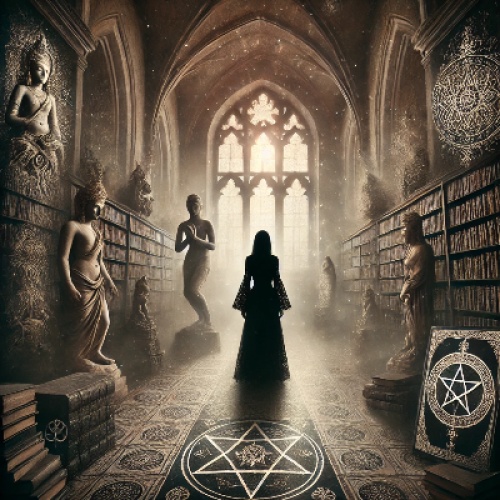As someone who has always rejected the mainstream, embraced the goth music knowing its roots deriving from Punk, I have rejected the mainstream it being the purpose of Punk, reveled in the beauty of the obscure, I've spent my life questioning the world around me as I got passionate to this music genre. Art, psychology, appreciating religions and cultures, music, questioning political religion, mainstream culture - these weren't just interests but obsessions. So, when I opened those ancient texts, I was prepared for stories of pain and resistance. What I wasn't prepared for was the weight of what I would uncover.
The pages whispered of South Asia, my origin were I myself had faced and forced to apply toxic ideologies of oppression and denial of individual expression such as having a love for tattoos, wearing what I want or dying hair or getting piercing or loving music and being a part of counterculture. I questioned why is oppression based on genders?
Not just women but the third-gender community who held positions of power and influence during the Mughal Empire. Guardians of harems, advisors to queens, generals in armies - their roles shattered the binaries I grew up resenting. The inked words seemed alive, pulling me into their world. I could almost see the palaces, the shimmering silks, the quiet dignity of those who existed beyond categories. But the beauty of the past was laced with bitterness.
The text detailed how colonialism severed these threads. How could a society so rich in its embrace of difference allow itself to be shackled? Was it sheer force, or was there something deeper, something complicit, that let these histories slip into silence? My hands trembled as I asked myself: "Why does the land that claims to have birthed powerful communities now condemn them to shadows? " Why does the same land blame colonizers today and not evolve and end oppression?
I poured over data, interviews, fragments of stories scattered like ashes across time. The erasure wasn't just the work of colonizers but today it's the opposite! As I thought of the hijras who survive today, ostracized yet unyielding, I felt a strange kinship. They, too, were rebels against a society that demanded conformity. Like the goth counterculture I clung to, they existed in defiance of the norm.
But history had its darker sides too. The pages of the text I clutched spoke not only of those celebrated but of the violence that accompanied resistance. Women, too, faced horrors unspoken in gilded narratives. Stories of queens poisoned in secret, of women tortured in dungeons for their defiance, whispers of witches burned in the name of piety - these stories weren't footnotes. They were the spine of history's cruelty.
History isn't just a list of events; it's a ghost. And as I sat surrounded by the weight of that truth, I whispered to no one but the shadows: "History is a specter, lingering at the edges of our vision, demanding to be seen."
The chill of the old monuments seeped into my bones as I wandered through its cavernous halls, a place that felt both sacred and suffocating. Gothic arches loomed above me, their intricate designs whispering of a time when belief was art and self-expression, not a weapon. I came here to confront the paradoxes of faith - not in prayer, but in defiance.
Flipping through a brittle journal I'd unearthed in the library, I researched, tales of monks and saints who defied gender norms. Joan of Arc's fiery conviction burned in my mind, a figure both celebrated and condemned. But it wasn't just her. There were tales of women accused of sorcery, mutilated in inquisitions, their crime often simply existing outside the bounds of what was considered "proper." How had we gone from these complex histories to the rigid binaries of modern conservatism? "What happened?" I whispered to the stained-glass saints, their silent eyes offering no answers.
Data from today's world painted a grim picture. Religion, once a source of transcendence, had become a tool for control. Laws that targeted transgender people weren't about faith; they were about fear. My journal filled with notes on these legislative battles, but my heart ached for the people behind the policies. "How did houses of worship inspired so much yet leave behind such cruelty?" I asked.
Yet, I also found solace here. The hymns echoing from the organ, the flicker of candles against the dark - these reminded me that faith and art are not the same as dogma. The goth counterculture, with its celebration of the other, had taught me this as I interacted with other alternative communities, I felt that. "We reclaim what they fear," I thought, as I scribbled a final note.
If history is a ghost, then Indigenous stories are its most haunting whispers. The worn maps and scattered fragments on my desk told tales of Two-Spirit identities, sacred roles that thrived before colonization cast its iron shadow. I felt a pang of sorrow as I read, knowing how settlers had wielded their binaries like weapons, tearing apart what they couldn't understand, how religions and cultures never showed cultural appreciations and only adaption.
The weight of these erasures pressed on me as I listened to goth songs as they reminded me of all the taboo topics, the darkness which people should love. I'd it all unearthed online and in musical contexts. Their melodies, defiant against centuries of silence, wrapped around me like a shroud. I listed lines in my journal: "Art persists where words are silenced."
The data was clear: communities once revered had been cast into marginalization, yet they fought on. Activists, and artists carried the light of those who came before them. But in my research, darker truths emerged. Inquisition records, colonial ledgers, whispered tales of women enslaved or executed for stepping outside rigid gender roles - all tied into the same specter of control.
"Could art be the weapon against erasure?" I asked the shadows. They didn't answer, but the songs did, the supportive community of the counterculture did.
South Asia called me back with its contradictions. I sat beneath the soft glow of my desk lamp, staring at photos of ancient temples. Sculptures of Ardhanarishvara such which is a deity in Hindu mythology that represents the union of masculine (Shiva) and feminine (Parvati) principles in a single form. It symbolizes the blending of opposites: male and female, creation and destruction, stillness and motion.
The Taj Mahal, often seen as a monument to love, could symbolize timeless beauty and the interplay of human emotion and divine inspiration. Taj Mahal Shiva, half their androgynous forms challenging everything the modern world claimed was fixed.
How did we go from this to laws that criminalize existence? Promote anti adaption and anti-coloniasm. "South Asians blames colonizers, but would not read these parts of their own rich culture or even appreciate other cultures to understand what was changed? I scrawled angrily in my notebook. Beauty and pain intertwined in every line I wrote. The religious monuments, temples, art museums celebrate unity, but society now punished difference. It was a bitter irony I couldn't shake.
Still, I couldn't deny the power of art. These temples weren't just relics; they were resistance. They were also sanctuaries for women marked as "dangerous" for their independence.
It always comes back to the ETERNAL QUESTIONS. As a goth, I've lived my life in rebellion, rejecting the easy answers of mainstream culture without their backup through research and claim to blindly believe what they have been taught. But in these histories, I found something deeper. They weren't just stories of oppression; they were stories of survival, of beauty, of art defying the confines of time.
Sitting in the dim light of my room, I began to write my manifesto. "We must embrace the specter of history," I wrote, "not as something to fear but as something to learn from. To be goth is to live with paradox, to celebrate the fleeting shadows of existence while fighting for what endures."
I closed the journal, my painted nails tapping against its cover. This wasn't the end. The world is vast, and its stories are infinite. But for now, I had learned one truth: rejecting the mainstream doesn't mean rejecting humanity! It means finding the beauty in its forgotten corners and we as a counterculture stand for that!
And as I blew out the candle while holding the goth aesthetics cross of Jesus's sacrifice, the shadows lingered, silent and eternal while and I said " Next time I will buy a dragon inspired by Chinese Zodiac and as well as Moon to remember the dead pentagram to remember the witches as I am a devil for the mainstream culture after all" :)





